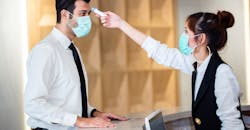It's understandable that many manufacturers are reluctant to allow any visitors to come onto their premises, given recent health concerns. Between a fear of hosting COVID-19 on their sites and the difficult task of determining protections for those working there, many manufacturers remain in a state of uncertainty.
Inviting someone to your plant to quote insurance may not be something that’s time sensitive, some forms of maintenance checks like testing a sprinkler system, having electrical inspections, and other forms of routine maintenance may lead to losses if they are not done in a timely manner.
As a safety services consultant, I’ve had time to evaluate these issues and compile some tips that might be useful to your manufacturing business. However, before taking actions specific to your business, always remember to first consult local experts and members of your plant management team.
Allowing visitors into your business — When your team begins evaluating upcoming visitor appointments, determine whether delaying the meeting could have an adverse effect on your manufacturing business. It may be possible to perform some functions virtually, while other meetings may have the potential to be done when plant employees are not present, or when numbers are reduced during break periods.
Other meetings may be scheduled for emergency repairs or require the presence of visitors when operations are being performed, and you will want to be prepared for how these meetings take place.
As the meeting approaches, remain transparent and flexible in case further rescheduling is needed. Most importantly, closely monitor how far you push back certain meetings. Delayed maintenance or safety visits could create an added injury risk to your employees or increased potential for property losses.
For those occasions when visitors need to be onsite and enter your plant or offices, it’s important to create a pre-screening process.
As part of that process, you may consider requiring visitors to answer a short questionnaire. It should include inquiries about:
• Whether the visitors have traveled outside their local community in the past 14 days;
• Whether they have had any close contact with people who have tested positive for COVID-19;
• Whether they currently are experiencing any unexplained health symptoms;
If you do allow visitors into your business keep a record of who has visited, so you can notify them in the event that someone there later tests positive for the virus. But, be careful not to reveal the names or other identifying information of anyone, maintaining confidentiality.
Determining if a visitor has symptoms — Of course, it’s up to you to decide how you will verify whether visitors are or are not showing symptoms. Some manufacturers now ask that you call before you arrive, so they can ask questions over the phone and deny entry if there’s a concern.
Another option is a questionnaire to be completed and returned electronically prior to the meeting. There’s also a phone app that employees and subcontractors fill out before leaving home. Those results are checked immediately by someone who can address any concerns and provide an approval or denial. Still other businesses take a visitor’s temperature before allowing him or her to enter the building.
Deciding what safeguards are required — Social distancing and proper personal hygiene are two of the leading ways recommended by medical experts to avoid spreading a disease. However, in some plants and operations it may be difficult to prevent individuals from getting closer than six feet apart.
For the comfort of employees and visitors, the best approach will be to have your safety leaders set a specific plan for distancing and personal protective equipment (PPE). Think of visitors as guests in your facility and help them make choices that will avoid uncomfortable contact with employees. If that includes wearing a mask or using hand sanitizer after entry, set that policy and make those items available to visitors.
Conducting business, but not in person — Technology makes it possible to meet with your vendors and suppliers while limiting physical contact. Consider whether these alternatives may work at your operation:
• Hold Zoom, Skype, or other online meetings for discussions with vendors who do not need to be physically present at your manufacturing location.
• Provide photos using a checklist provided by vendors who may need to examine a possible facility safety risk, or evaluate a concern over specific equipment to help decide if an in-person visit is needed.
• Set up no-contact or limited-contact drop-off/pick-up locations for supply deliveries.
Above all else, ensure that any policy you set follows all state and/or local requirements for social distancing and the use of personal protective equipment.
Going forward, it's important to remember that the public health impact of COVID-19 is continually evolving. As such, you will need to continually assess your approach to establishing a safe work environment. A proactive approach may prevent health issues at your manufacturing business and prevent further transmission of COVID-19—now and in the future.
Ken Alderden is a Senior Safety Services Consultant for Sentry Insurance a Mutual Company. Sentry provides business insurance and safety services for businesses and manufacturers. Contact him via LinkedIn.
